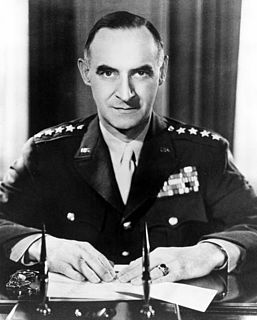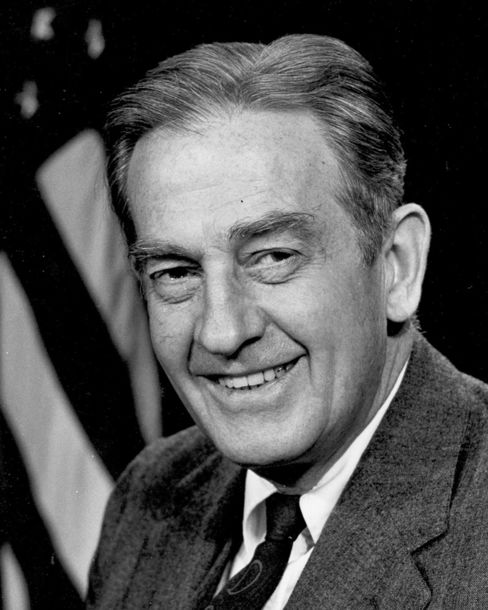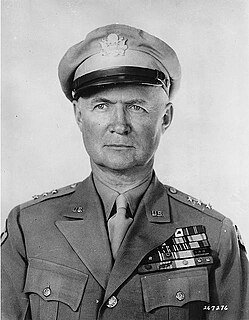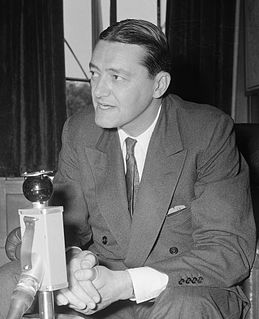Related Research Articles

Dwight David "Ike" Eisenhower was an American military officer and statesman who served as the 34th president of the United States from 1953 to 1961. During World War II, he served as Supreme Commander of the Allied Expeditionary Force in Europe, and achieved the rare five-star rank of General of the Army. He was responsible for planning and supervising the invasion of North Africa in Operation Torch in 1942–1943 and the successful invasion of Normandy in 1944–1945 from the Western Front.

General Lucius Dubignon Clay was a senior officer of the United States Army who was known for his administration of occupied Germany after World War II. He served as the deputy to General of the Army Dwight D. Eisenhower in 1945; deputy military governor, Germany, in 1946; Commander in Chief, United States Forces in Europe and military governor of the United States Zone, Germany, from 1947 to 1949. Clay orchestrated the Berlin Airlift (1948–1949) when the USSR blockaded West Berlin.

Morristown–Beard School is a coeducational, independent, college-preparatory day school located in Morristown, in Morris County, New Jersey, United States. Serving students in sixth through twelfth grades, the school has two academic units: an Upper School (9-12) and a Middle School (6-8).

Clifford Philip Case, Jr., was an American lawyer and politician. A member of the Republican Party, he served as a U.S. Representative (1945–1953) and a U.S. Senator (1955–1979) from New Jersey.
Robert Henry Winborne Welch Jr. was an American businessman and political organizer. He was wealthy following his retirement from the candy business and used it to sponsor anti-communist causes. He co-founded the far right group the John Birch Society (JBS) in 1958 and tightly controlled it until his death. He was highly controversial and criticized by liberals, as well as some conservatives, including William F. Buckley Jr.

Dwight D. Eisenhower's tenure as the 34th president of the United States began on his inauguration on January 20, 1953, and ended on January 20, 1961. Eisenhower, a Republican, took office as president following his victory over Democrat Adlai Stevenson in the 1952 presidential election. John F. Kennedy succeeded him after winning the 1960 presidential election.

Wilson Allen Wallis was an American economist and statistician who served as president of the University of Rochester. He is best known for the Kruskal–Wallis one-way analysis of variance, which is named after him and William Kruskal.

Lieutenant General Willis Dale Crittenberger was a senior officer of the United States Army. He was a career soldier who served with distinction during the Italian Campaign of World War II.

John Moors Cabot was an American diplomat and U.S. Ambassador to five nations during the Truman, Eisenhower, and Kennedy administrations. He also served as Assistant Secretary of State for Inter-American Affairs. He warned repeatedly of the dangers of Soviet communism toward American interests in Latin America.

Gabriel Hauge was a prominent American bank executive and economist. Hauge served as assistant to the President for Economic Affairs during the administration of Dwight D. Eisenhower.
James M. Lambie, Jr. served in the Eisenhower Administration (1953–1961) as Special Assistant and Assistant Staff Secretary coordinating public information programs between the Advertising Council and the U.S. government.
Ann Cook Whitman was a native of Perry, Ohio. She briefly attended Antioch College in Ohio and then moved to New York in 1929 to obtain work as a secretary. For many years she was the personal secretary to Mrs. David Levy, whose father was one of the founders of Sears, Roebuck and Company. In 1941 she married Edmund S. Whitman, an official of the United Fruit Company.
William Bernard Herlands was a United States District Judge of the United States District Court for the Southern District of New York.
James Hopkins Smith Jr. was United States Assistant Secretary of the Navy (AIR) from 1953 to 1956 and then was head of the United States Agency for International Development from 1957 to 1959.

Arthur Hendrick Vandenberg Jr. was a Republican government official from Michigan. He worked for many years on the staff of his father, Arthur H. Vandenberg (1884–1951), who served in the U.S. Senate from 1928 to 1951. He was briefly appointed to Eisenhower's White House staff in November 1952 but resigned in 1953 at the very start of the Eisenhower administration. He also worked as a consultant and academic and edited his father's papers for publication.

The Crusade for Freedom was an American propaganda campaign operating from 1950–1960. Its public goal was to raise funds for Radio Free Europe; it also served to conceal the CIA's funding of Radio Free Europe and to generate domestic support for American Cold War policies.

Philip Young was an American government official and diplomat who served as United States Ambassador to the Netherlands.
Roy Tasco Davis was an American diplomat who served as ambassador to Costa Rica, Haiti, Panama.
Lawrence Asa (Larry) Appley was an American management specialist and organizational theorist, known for his early work on management and organization, especially quality management. In 1962 he was awarded the Henry Laurence Gantt Medal.
This bibliography of Dwight D. Eisenhower is a list of published works about Dwight D. Eisenhower, the 34th president of the United States.
References
- 1 2 3 4 5 6 "William Greene, Publicity Aid". The New York Times. January 28, 1967.
- ↑ "School and College Holiday Hockey Program Will Get Under Way on Saturday in Garden: Morristown School Hockey Squad Which Will Meet Kent School in Garden on Saturday". The New York Times. December 14, 1931.
- 1 2 3 4 "Crusade for Europe gets an active, athletic head". Tide: The Newsmagazine of Advertising and Marketing. Tide Publishing Company. 28: 202. 1954.
- ↑ "Anne D. Holt Engaged to Philip W. Greene; Graduate of Masters School to be Wed to Yale Alumnus". The New York Times. September 15, 1941.
- ↑ "Advertising News and Notes". The New York Times. November 23, 1948.
- ↑ "Advertising News and Notes; Improved Research Urged Accounts Personnel Notes". The New York Times. April 21, 1950.
- ↑ "Records Forecast in Advertising Use". The New York Times. July 17, 1953.
- ↑ "Gen. Smith Elected to Head Foundation". The New York Times. November 5, 1954.
- ↑ Eisenhower, Dwight D (1958). "Public Papers of Dwight D. Eisenhower". Public Papers of the Presidents of the United States: Dwight D. Eisenhower, 1956 . p. 347.
- ↑ "Crusade for Freedom; White House press release dated March 27". Department of State Bulletin. 34 (875): 636. 1956.
- ↑ "Letter to William A. Greene, President, Crusade for Freedom".
- ↑ "Crusade Drive Gains; Mrs. Eisenhower Gives Fund from Staff--Gets Poppy". The New York Times. March 28, 1956.
- ↑ "A Freakish Hole-in-One". The New York Times. August 12, 1941.
- ↑ "New York Golfer Scores Longest Ace on Record". The Washington Post. United Press International. August 12, 1941.
- ↑ "Anne Holt Is Married; Becomes Bride of Philip William A. Greene in Great Neck, L.I.". The New York Times. December 1, 1941.